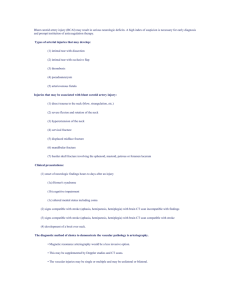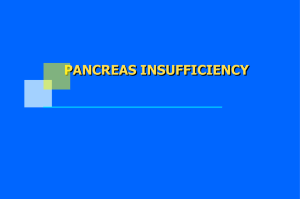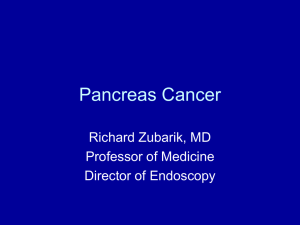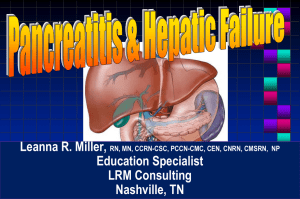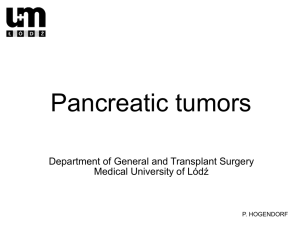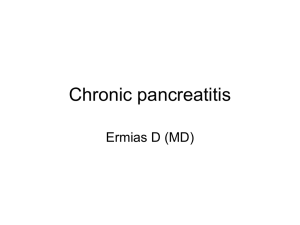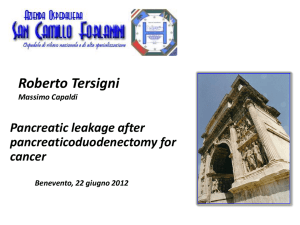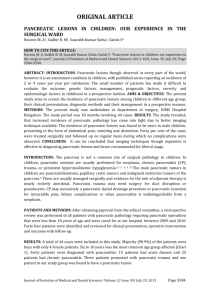Pancreatic fracture
advertisement
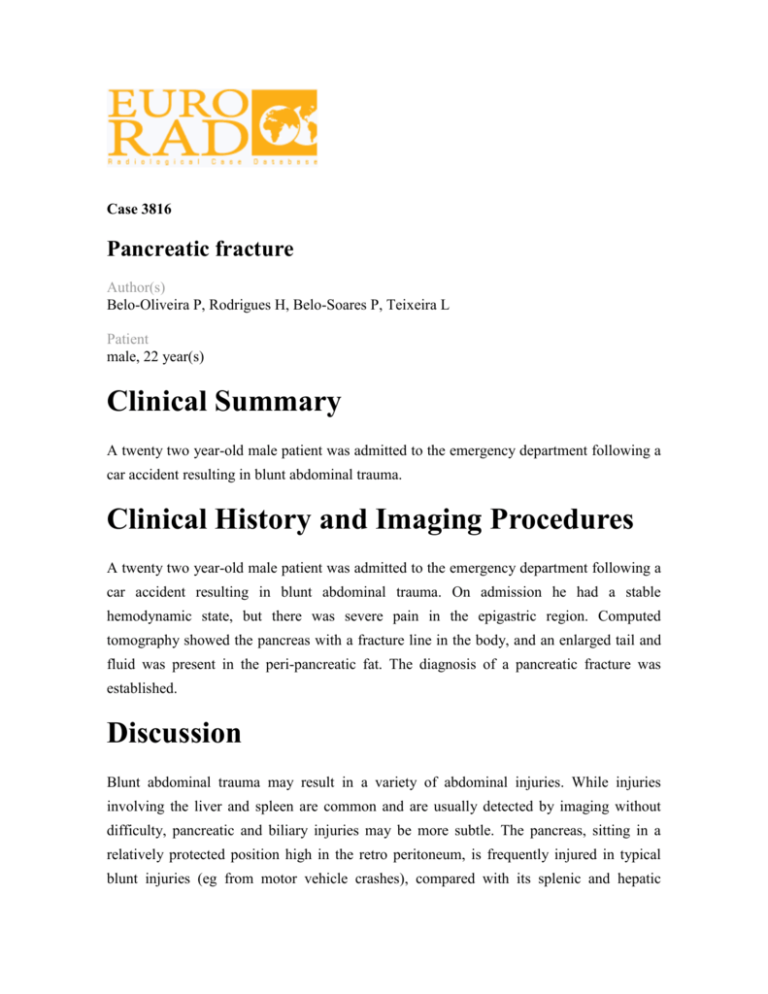
Case 3816
Pancreatic fracture
Author(s)
Belo-Oliveira P, Rodrigues H, Belo-Soares P, Teixeira L
Patient
male, 22 year(s)
Clinical Summary
A twenty two year-old male patient was admitted to the emergency department following a
car accident resulting in blunt abdominal trauma.
Clinical History and Imaging Procedures
A twenty two year-old male patient was admitted to the emergency department following a
car accident resulting in blunt abdominal trauma. On admission he had a stable
hemodynamic state, but there was severe pain in the epigastric region. Computed
tomography showed the pancreas with a fracture line in the body, and an enlarged tail and
fluid was present in the peri-pancreatic fat. The diagnosis of a pancreatic fracture was
established.
Discussion
Blunt abdominal trauma may result in a variety of abdominal injuries. While injuries
involving the liver and spleen are common and are usually detected by imaging without
difficulty, pancreatic and biliary injuries may be more subtle. The pancreas, sitting in a
relatively protected position high in the retro peritoneum, is frequently injured in typical
blunt injuries (eg from motor vehicle crashes), compared with its splenic and hepatic
counterparts. Injuries of the pancreas, gallbladder, and bile ducts due to blunt trauma are
rare and difficult to detect but are associated with high morbidity and mortality, especially
if diagnosis is delayed. Accurate and early diagnosis is imperative, and imaging plays a key
role in detection. Knowledge of the mechanisms of injury, the types of injuries, and the
roles of various imaging modalities is essential for prompt and accurate diagnosis. Injury to
the pancreas is relatively uncommon, occurring in less than 2% of blunt abdominal trauma
patients. The pancreas is vulnerable to crushing injury in blunt trauma due to the impact
against the adjacent vertebral column. Two-thirds of pancreatic injuries occur in the
pancreatic body, and the remainder occurs equally in the head, neck, and tail. Symptoms
and clinical findings are often nonspecific and unreliable. The classic triad of fever,
leukocytosis, and elevation of serum amylase levels is rarely encountered. CT is routinely
used as first-line imaging in the acute trauma patient and can be helpful in defining injuries
to the pancreas and associated complications. For blunt abdominal trauma, CT images are
usually obtained in the portovenous phase, 60–70 seconds after injection of iodinated
contrast media. Ideally, the section collimation is 5 mm or less, with at least a 20% overlap
between adjacent reconstructed images. Direct signs of pancreatic injury include pancreatic
laceration, transection, and comminution. Fluid collections, such as hematomas,
pseudocysts, and abscesses, are often seen communicating with the pancreas at the site of
fracture or transection. Focal enlargement of the pancreas and peripancreatic fluid is
suggestive of pancreatic injury, and faint fracture lines may be seen on close inspection.
Peripancreatic fat stranding, haemorrhage, and fluid between the splenic vein and pancreas
are useful secondary signs. The prognosis of pancreatic injuries is primarily related to the
integrity of the pancreatic duct. Therefore, any patient with pancreatic injuries at CT or
with
a
high
clinical
index
of
suspicion
should
be
considered
for
MR
Cholangiopancreatography or Endoscopic retrograde pancreatogram for direct imaging of
the pancreatic duct. Since delay in diagnosis increases the risk of delayed complications,
MR Cholangiopancreatography should be performed promptly in all patients with
suspected pancreatic injury, ideally within 24–48 hours of initial injury. If imaging of the
pancreatic duct is not adequate or an injury is detected that might be amenable to stent
placement, ERCP should be performed promptly. CT is also helpful for detecting delayed
complications of pancreatic injury, such as abscesses, pseudo cysts, and development of
fistulous tracts.
Final Diagnosis
Pancreatic fracture
MeSH
1. Pancreatic Diseases [C06.689]
References
1. [1]
Traumatic fracture of the pancreas: CT characteristics. Dodds WJ, Taylor AJ,
Erickson SJ, Lawson TL J Comput Assist Tomogr. 1990 May-Jun;14(3):375-8
2. [2]
Value of computed tomography in the evaluation of retroperitoneal organ injury in
blunt abdominal trauma. Porter JM, Singh Y Am J Emerg Med. 1998
May;16(3):225-7
3. [3]
Blunt abdominal trauma in adults: role of CT in the diagnosis and management of
visceral injuries. Part 2: Gastrointestinal tract and retroperitoneal organs. Becker
CD, Mentha G, Schmidlin F, Terrier F Eur Radiol. 1998;8(5):772-80
Citation
Belo-Oliveira P, Rodrigues H, Belo-Soares P, Teixeira L (2005, Jun 17).
Pancreatic fracture, {Online}.
URL: http://www.eurorad.org/case.php?id=3816
DOI: 10.1594/EURORAD/CASE.3816
To top
Published 17.06.2005
DOI 10.1594/EURORAD/CASE.3816
Section Gastro-Intestinal Imaging
Case-Type Clinical Case
Views 71
Language(s)
Figure 1
Abdominal CT
Axial contrast-enhanced CT scan shows a complete fracture of the pancreatic body with
fluid and haemorrhage between the pancreatic fragments
Figure 2
Abdominal CT
Axial contrast-enhanced CT scan shows slight enlargement of the pancreatic tail with a
fluid collection.
Figure 3
Abdominal CT
Axial contrast-enhanced CT scan shows a fluid collection at the pancreatic tail
Figure 1
Abdominal CT
Axial contrast-enhanced CT scan shows a complete fracture of the pancreatic body with
fluid and haemorrhage between the pancreatic fragments
Figure 2
Abdominal CT
Axial contrast-enhanced CT scan shows slight enlargement of the pancreatic tail with a
fluid collection.
Figure 3
Abdominal CT
Axial contrast-enhanced CT scan shows a fluid collection at the pancreatic tail
To top
Home Search History FAQ Contact Disclaimer Imprint



